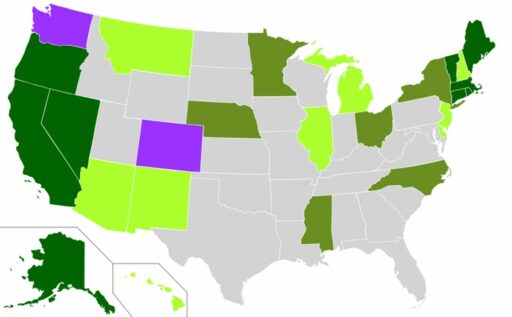Oklahoma’s medical marijuana landscape has undergone a rapid and tumultuous transformation since the state legalized the cultivation and sale of cannabis for medicinal purposes in 2018. The absence of a cap on dispensaries and grows, combined with lenient regulations, has attracted a rush of local and out-of-state investors, including criminal enterprises. This article delves into the explosive growth of Oklahoma’s medical marijuana dispensaries, the challenges posed by the black market, the impact of the COVID-19 pandemic, and the future of cannabis legalization in the state.
Key Takeaways
- Oklahoma’s medical marijuana industry experienced unprecedented expansion due to permissive laws, leading to nearly 10,000 licensed grows by the end of 2021.
- The lack of stringent regulations attracted criminal groups, including mafias and Chinese syndicates, contributing to a robust black market.
- COVID-19 prompted regulatory changes and shifts in consumer behavior, forcing the cannabis industry to adapt to new market dynamics.
- Comparisons with other states reveal that Oklahoma’s lax approach to cannabis regulation has had both positive and negative repercussions on its market.
- As Oklahoma approaches a vote on recreational cannabis legalization, potential reforms and technological innovations are set to shape the future of the industry.
The Birth of a Green Frontier: Oklahoma’s Medical Marijuana Boom

The 2018 Ballot Measure and Its Aftermath
In 2018, Oklahoma became a focal point in the national dialogue on cannabis legalization when voters approved State Question 788, legalizing medical marijuana. This landmark decision catalyzed the state’s green rush, setting the stage for a burgeoning industry with minimal barriers to entry. The aftermath of the ballot measure saw a rapid and unprecedented rise in the number of dispensaries and grows across the state.
The initial regulatory framework, or lack thereof, allowed for an almost free-for-all market environment. Entrepreneurs and patients alike flocked to take advantage of the new opportunities, resulting in a dramatic spike in business applications:
- In the first year, over 2,000 dispensary licenses were issued.
- Cultivation licenses soared, with more than 1,000 granted in the same period.
- The state collected millions in application fees and taxes, bolstering its economy.
The sheer speed of growth in the Oklahoma medical marijuana sector outpaced the state’s ability to regulate it, leading to a complex tapestry of challenges and opportunities for those involved.
As the dust settled, it became clear that the green rush in Oklahoma was not just a local phenomenon but had significant implications for the national landscape of cannabis legalization.
Regulatory Gaps and the Influx of Out-of-State Interests
The medical marijuana landscape in Oklahoma has been marked by a rapid expansion, fueled in part by regulatory gaps that have attracted a significant number of out-of-state interests. The state’s legislation initially did not fully address the complexities of interstate commerce, inadvertently paving the way for an influx of investors and operators from beyond Oklahoma’s borders.
Despite federal law prohibiting the shipment of cannabis products across state lines, limited enforcement efforts have allowed for the covert trafficking of marijuana. This has been exacerbated by the recruitment of illegal "straw owners"—individuals who register businesses on behalf of those who cannot legally do so. The combination of these factors, along with the affordability of land, has contributed to the industry’s explosive growth.
The unchecked expansion of the medical marijuana industry has positioned it as a formidable force in Oklahoma’s economy, rivaling even the oil and gas sector in its influence and reach.
While some states, like California, have begun exploring the possibility of legal interstate cannabis transfers, Oklahoma grapples with the challenges posed by its current regulatory framework. The state’s experience serves as a cautionary tale for other regions considering the legalization of medical marijuana.
The Proliferation of Dispensaries and Grows
The landscape of Oklahoma’s medical marijuana industry has been transformed by a remarkable surge in the number of dispensaries and grow operations. The state has become a beacon for cannabis entrepreneurs, drawn by the relatively low barriers to entry and the promise of a burgeoning market. This rapid expansion, however, has not been without its challenges.
The following table illustrates the growth in dispensary numbers over recent years:
| Year | Number of Dispensaries |
|---|---|
| 2019 | 1,500 |
| 2020 | 2,000 |
| 2021 | 2,500 |
| 2022 | 3,000 |
The saturation of the market has led to fierce competition, with some businesses struggling to maintain profitability amidst declining prices and an oversupply of product.
As the industry continues to evolve, stakeholders are calling for more robust regulatory frameworks to ensure the market’s sustainability and to protect consumers. The current trajectory suggests that the Oklahoma medical marijuana landscape will continue to be dynamic, with further changes and developments anticipated in the coming years.
The Underbelly of the Boom: Criminal Enterprises and Black Market Dynamics

The Mafia’s Grip on the Green Rush
The infiltration of the Oklahoma medical marijuana industry by organized crime has become a significant concern. State investigators have identified a strong presence of Chinese organized crime in the state’s illicit marijuana operations. These criminal groups have not only capitalized on the green rush but have also brought with them a host of illegal activities, including violence and money laundering.
The dominance of these mafias in the cannabis market is not just a local issue but part of a global trend. In recent years, Chinese mafias have become the primary money launderers for drug cartels, with marijuana sales providing a substantial revenue stream. This financial power has bolstered their underground banking networks, which are considered the most extensive in the world.
The surge in illicit marijuana cultivation and distribution by these groups has led to a myriad of criminal activities, from environmental damage to public safety threats. The scale of the problem is highlighted by the fact that over 3,000 illegal grows have been linked to foreign mafias, with a significant majority being of Chinese origin.
The profits from marijuana are not just funding the local operations but are also funneled into other criminal enterprises. These include smuggling, document fraud, and other forms of financial crime, creating an interconnected web of illegal activities that extend far beyond Oklahoma’s borders.
Chinese Syndicates and Interstate Trafficking
The surge of Oklahoma’s medical marijuana dispensaries has inadvertently paved the way for sophisticated criminal networks to thrive. Chinese organized crime syndicates have become a dominant force in the illicit marijuana trade across the United States, from the West to the East Coast. These groups, often referred to as triads, have established a notorious presence, engaging in activities such as drug trafficking, money laundering, and violence.
The triads’ operations are characterized by a high degree of organization and discipline, with a command structure that extends from New York and is deeply rooted in southern China. Their expansion into the cannabis market has not only increased their influence in the criminal underworld but also bolstered their role in global money laundering, particularly for Latin American drug cartels.
The illicit proceeds from marijuana sales contribute to a vast underground financial network, which is considered the most extensive in the world. This network supports a variety of criminal activities, including migrant smuggling and other interconnected rackets.
The profitability of the marijuana black market has attracted various criminal entities, but the Chinese syndicates stand out for their efficiency and reach. The table below highlights the stark contrast in profit margins between the West and East Coast markets, which drives the interstate trafficking of cannabis:
| Region | Average Wholesale Price per Pound |
|---|---|
| West Coast | $500 – $700 |
| East Coast | $3000 – $4000 |
This lucrative trade has not gone unnoticed by law enforcement, which continues to grapple with the challenges posed by these highly organized criminal enterprises.
Law Enforcement’s Battle Against Illicit Operations
The battle against illicit cannabis operations is a complex endeavor, with law enforcement agencies facing significant challenges. The lack of specialized knowledge and language skills among personnel hampers the investigation and infiltration of sophisticated networks. A shift in federal priorities has led to a scarcity of resources dedicated to combating Chinese organized crime, which has only grown in power and influence over the years.
Despite these obstacles, there have been concerted efforts to dismantle these operations. Collaborative efforts involving the FBI, DEA, IRS, and Homeland Security Investigations have yielded results, although such federal offensives remain rare. The reluctance of federal prosecutors to charge cases related to illicit marijuana is a notable hurdle, as they often overlook the broader criminal implications tied to the trade.
The profits from the marijuana trade not only fuel the expansion of criminal networks but also bolster a global underground banking system that serves various cartels and criminal organizations.
During operations like the Sacramento area’s Operation Lights Out, the discipline and financial capabilities of these networks become evident, underscoring the scale and organization behind their illegal activities.
Impact of the Pandemic on Oklahoma’s Cannabis Industry

Regulatory Changes Amidst COVID-19
The COVID-19 pandemic brought about significant regulatory changes within Oklahoma’s medical marijuana landscape. Businesses faced new challenges, adapting to social distancing requirements and shifting consumer demands. In response, regulators implemented measures to ensure the continuity of the industry while prioritizing public health.
- Curbside pickup and delivery options were introduced to minimize contact.
- Temporary licenses for out-of-state patients were extended to accommodate travel restrictions.
- Renewal deadlines for medical marijuana cards were deferred, providing relief to patients.
The industry’s resilience was tested as it navigated through the uncharted waters of a global health crisis, with many businesses swiftly adopting innovative solutions to maintain operations.
These changes underscored the need for agility in regulatory frameworks to support the industry’s sustainability during unprecedented times. As Oklahoma continues to adjust its policies, the lessons learned during the pandemic are likely to influence future regulatory approaches.
The Shift in Consumer Behavior During the Pandemic
The onset of the COVID-19 pandemic brought about significant changes in consumer behavior within the Oklahoma medical marijuana industry. Increased demand and shifts in purchasing patterns became evident as customers adapted to new public health measures and lifestyle changes.
- Consumers showed a preference for larger, less frequent purchases to minimize exposure and comply with social distancing.
- There was a noticeable uptick in the use of delivery services and curbside pickups.
- The pandemic also accelerated the adoption of cashless payments and online ordering systems among dispensaries.
The industry’s resilience was tested, but it adapted quickly to meet the evolving needs and concerns of consumers.
These behavioral shifts are expected to have long-lasting effects on the industry, even as the pandemic wanes. Operators who continue to prioritize safety and convenience for their customers are likely to see sustained growth.
Adapting to New Challenges in the Cannabis Market
As the cannabis industry in Oklahoma continues to evolve, businesses are facing a new set of challenges in the wake of the pandemic. Adherence to changing regulations and consumer safety has become paramount, with the industry striving to maintain the momentum it gained during the pandemic. The ability to pivot and adapt has been crucial for dispensaries and growers alike.
- Regulatory compliance and safety protocols
- Diversification of product offerings
- Embracing e-commerce and delivery services
- Strengthening supply chain resilience
The cannabis market’s agility in responding to the pandemic’s disruptions showcases its potential for sustained growth. The focus on innovation and compliance will likely dictate the success of businesses moving forward.
The landscape of the cannabis industry is in constant flux, with operators needing to stay informed and proactive. The biggest challenges lie ahead, and those who can navigate the changing tides will emerge stronger.
Comparative Analysis: Oklahoma Versus Other States

Lax Regulations and the Resulting Expansion
Oklahoma’s medical marijuana landscape has been characterized by minimal regulatory hurdles, leading to an unprecedented number of dispensaries and grows. This rapid expansion can be attributed to several factors, including the absence of a cap on the number of licenses issued and the low barriers to entry for prospective business owners.
- Low application fees and minimal requirements have made Oklahoma an attractive state for cannabis entrepreneurs.
- The state’s non-resident ownership allowance has drawn significant out-of-state investment.
- Enforcement challenges have led to issues with illegal operations and black market proliferation.
The industry’s growth has been explosive, with some comparing its scale only to the state’s oil and gas sector. However, this has come at a cost, with a drop in wholesale marijuana prices and a rise in associated criminal activities.
Despite the criticism of marijuana enforcement in 2023, there is a clear need for more oversight to stabilize the industry and recover wholesale prices. The current situation has led to a generalized surge in crime, affecting not only the cannabis industry but also the broader community.
Lessons Learned from Oklahoma’s MMJ Legalization
Oklahoma’s journey with medical marijuana (MMJ) has been a learning curve for both the state and observers nationwide. The rapid expansion of dispensaries and grows highlighted the need for robust regulatory frameworks. The state’s experience underscores the importance of balancing accessibility with oversight to prevent exploitation by criminal elements and ensure patient safety.
- Regulatory oversight is crucial to mitigate the risks of over-saturation and illegal activity.
- Residency requirements can help maintain local control but may be circumvented without strict enforcement.
- Limitations on licenses could prevent market oversupply but must be weighed against patient access needs.
The Oklahoma model has demonstrated that a laissez-faire approach can lead to unintended consequences, such as the proliferation of out-of-state interests and the strain on law enforcement resources.
As other states consider legalization, they can draw from Oklahoma’s experiences to craft legislation that promotes a healthy medical marijuana industry while protecting against the risks of a rapidly growing market.
Influence on Future State Legalization Efforts
Oklahoma’s medical marijuana (MMJ) landscape has become a case study for other states considering legalization. The state’s rapid expansion and regulatory challenges offer valuable lessons for future legalization campaigns. Notably, the approach to licensing and regulation has been a focal point for policymakers elsewhere.
- Oklahoma’s low barriers to entry have led to a surge in dispensaries and grows.
- Other states are observing the impact of Oklahoma’s light-touch regulation on market dynamics.
- The balance between fostering industry growth and preventing criminal activity is a critical consideration.
The experiences in Oklahoma are shaping the discourse around cannabis legalization, influencing strategies that aim to balance economic opportunity with public safety and health concerns.
As states like Ohio and Florida move towards legalization, they are likely to draw on Oklahoma’s precedents. The outcomes of such efforts will further inform the national conversation on cannabis policy.
The Future of Cannabis in Oklahoma: Trends and Predictions

Potential Reforms and Industry Stabilization
As the Oklahoma medical marijuana industry matures, legislative updates are anticipated to address the challenges and opportunities that have emerged. The focus is on creating a more stable and credible market, with reforms potentially touching on liability, research facilitation, and physician engagement.
- Liability for cannabis-related activities is a key concern, with the aim to provide clearer guidelines and protections for businesses and consumers.
- Research barriers are expected to be reduced, allowing for more robust data collection and analysis to inform policy and business decisions.
- Physician engagement and medical community involvement are crucial for legitimizing the industry and ensuring patient safety.
The goal of these reforms is not only to support the growing American economy but also to ensure that the industry operates in a manner that is both responsible and sustainable.
With neighboring states observing closely, Oklahoma’s approach to cannabis reform could set a precedent for future regulatory frameworks. The Massachusetts Cannabis Control Commission’s recent amendments serve as an example of proactive changes aimed at equity and success in the cannabis market.
The Role of Technology and Innovation in Growth
As the cannabis industry evolves, technology and innovation are becoming pivotal in shaping its future. The integration of advanced cultivation systems, data analytics, and e-commerce platforms has not only streamlined operations but also enhanced the customer experience.
- Advanced cultivation systems have revolutionized the way cannabis is grown, with precise control over environmental factors leading to higher yields and quality.
- Data analytics is being leveraged to understand consumer trends, optimize supply chains, and forecast market movements.
- E-commerce platforms have made purchasing cannabis more convenient, expanding the market reach.
The synergy between technology and the cannabis sector is fostering a new wave of growth and efficiency, setting the stage for a robust and sustainable industry.
The adoption of digital infrastructure by entities like the Cherokee Nation exemplifies the broader trend of technological embracement. As we step into 2024, the cannabis industry in the United States stands on the cusp of an era marked by unprecedented growth, technological innovation, and regulatory shifts.
Forecasting the Recreational Cannabis Vote
As Oklahoma navigates the evolving landscape of cannabis legislation, the outcome of recent votes casts a shadow on the prospects of recreational marijuana legalization. Despite a surge in medical dispensaries, the recreational vote has faced setbacks. In March, Oklahoma voters rejected a measure to legalize recreational cannabis, reflecting a cautious stance among the electorate.
The following table outlines the status of marijuana legalization efforts in various states as of 2024:
| State | Medical | Recreational |
|---|---|---|
| Oklahoma | Yes | No |
| Indiana | Yes | No |
| Maryland | Yes | Yes |
| Missouri | Yes | Yes |
The pattern of voting behavior suggests a complex interplay between public opinion, regulatory frameworks, and advocacy efforts. The rejection in Oklahoma contrasts with the successful legalization in states like Maryland and Missouri, indicating a diverse national sentiment towards cannabis.
Analysts predict that the future of recreational cannabis in Oklahoma will depend on several factors, including shifts in public perception, the influence of industry stakeholders, and the impact of regulatory changes in neighboring states. The next few years will be critical in determining whether Oklahoma will join the growing number of states embracing full legalization.
Conclusion
As Oklahoma navigates the complexities of a burgeoning medical marijuana market, the state has become a case study in the challenges and opportunities presented by the ‘Green Rush.’ The absence of a cap on dispensaries and grows, coupled with minimal enforcement, has led to a surge in both legitimate businesses and illicit operations. With nearly 10,000 licensed grows at its peak and a significant number of them suspected of black market trafficking, Oklahoma’s experience underscores the importance of robust regulatory frameworks. The state’s journey serves as a cautionary tale for other regions considering legalization, highlighting the need for balance between economic growth and law enforcement to ensure a healthy, sustainable cannabis industry.
Frequently Asked Questions
What led to the surge of medical marijuana dispensaries in Oklahoma?
The surge was primarily due to the 2018 ballot measure that legalized the cultivation and sale of marijuana for medicinal purposes without limiting the number of dispensaries or grows, coupled with limited enforcement that attracted out-of-state interests.
How have criminal enterprises exploited Oklahoma’s medical marijuana boom?
Criminal enterprises, including mafias and Chinese syndicates, have exploited the lax regulations to establish a presence in the state, leading to illicit production and interstate trafficking of marijuana.
How did the COVID-19 pandemic affect Oklahoma’s cannabis industry?
The pandemic led to regulatory changes, shifts in consumer behavior, and forced businesses to adapt to new challenges, impacting the cannabis market in Oklahoma.
In what ways does Oklahoma’s medical marijuana industry differ from other states?
Unlike some states like California, Oklahoma did not limit the size of marijuana grows or the number of dispensaries, which led to a rapid and expansive growth of the industry.
What is the forecast for the recreational cannabis vote in Oklahoma?
As of early 2023, the vote on recreational cannabis in Oklahoma is approaching, and there is significant educational and advocacy efforts underway to influence the outcome.
What are the potential reforms and trends for the future of cannabis in Oklahoma?
Potential reforms may include stricter regulations and industry stabilization measures, with trends pointing towards the incorporation of technology and innovation to spur further growth.





